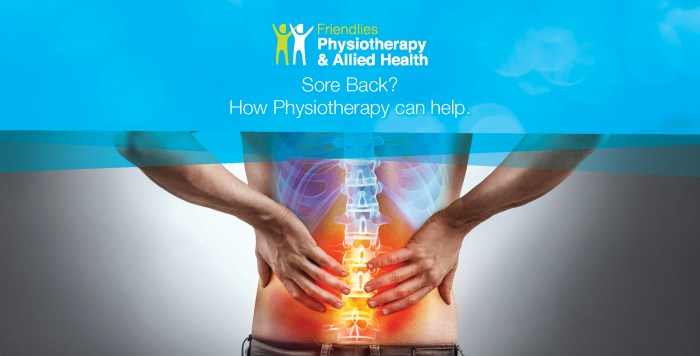
Welcome to the delightful world where back pain meets physiotherapy, where we tackle those stubborn aches like a game of whack-a-mole! Whether it’s from lifting your kids or lifting too many pizzas, back pain can be a real party crasher. Fear not, for physiotherapy is here to rescue your spine and get you grooving again!
Back pain can sprout from a multitude of sources, from poor posture to the occasional awkward sneeze. In this article, we’ll unravel the mystery behind back pain and explore how physiotherapy, with its magical techniques and exercises, can transform your life. From understanding the mind-body connection to introducing some lifestyle fixes, we’ll equip you with all the tools needed to reclaim your back.
Back Pain and Physiotherapy
Back pain is like that uninvited guest at a party that seems to linger far too long. It’s often caused by various factors—from poor posture to heavy lifting, or simply the wear and tear of daily life. Fortunately, physiotherapy offers an effective pathway to send that pesky pain packing, armed with techniques designed to restore functionality and ease discomfort.Physiotherapy tackles back pain through a comprehensive approach that combines assessment, treatment, and education.
This multifaceted strategy ensures that both the symptoms and underlying causes are addressed. Common causes of back pain include muscle strain, herniated discs, and even stress! Physiotherapists utilize a variety of techniques to alleviate pain, promote healing, and prevent recurrence. These techniques may include manual therapy, modalities like heat or cold treatment, and tailored exercise programs.
Physiotherapy Techniques for Back Pain Relief
A toolbox of effective techniques is employed by physiotherapists to combat back pain. Each method has its unique purpose and can be tailored to individual needs. Here are some of the standout techniques:
- Manual Therapy: This hands-on technique involves manipulating the spine and surrounding tissues to relieve pain and improve mobility. Think of it as a mini massage with a purpose!
- Electrotherapy: Utilizing electrical stimulation, this technique can help reduce pain and inflammation. It’s like giving your muscles a gentle wake-up call.
- Dry Needling: Inserting thin needles into trigger points can relieve tight muscles and restore function. It’s not as scary as it sounds—just consider it acupuncture’s cool cousin.
- Ultrasound Therapy: This method uses sound waves to promote tissue healing and reduce pain. It’s like sending little sonic vibrations to your back for a healing jolt.
Exercise and rehabilitation programs form the backbone (no pun intended) of effective back pain management in physiotherapy. These programs help strengthen the muscles that support the spine, enhance flexibility, and improve overall posture. Here’s how exercise makes a difference:
Role of Exercise and Rehabilitation Programs
Exercise isn’t just about lifting weights or running marathons; it’s a crucial component of back pain rehabilitation. The right exercises can help patients regain strength, improve mobility, and reduce the risk of future injuries. Well-structured rehabilitation programs might include:
- Stretching Exercises: Gentle stretches help alleviate muscle tension and improve flexibility. Picture yourself gracefully bending like a pretzel, minus the cheese!
- Strengthening Exercises: Targeted workouts build core strength, providing better support for the spine. This is like giving your back a superhero cape!
- Posture Training: Learning how to maintain proper posture can prevent further strain on the back. Imagine walking around like a proud penguin—straight and confident!
- Aerobic Conditioning: Low-impact activities like walking or swimming keep the body fit without overstraining the back. It’s like giving your heart a workout party while your back takes it easy.
By incorporating these exercises into daily routines, patients can experience significant improvements in their back health, paving the way for a more active and pain-free life. Whether you’re a desk jockey or a weekend warrior, physiotherapy is your ticket to a stronger, more resilient back.
Health Connections
Back pain doesn’t just mess with your spine; it can tangle the mind in a knot too! The intricate relationship between back pain and mental health is as complex as trying to untangle your earphones after they’ve been in your pocket for a while. Depression, anxiety, and stress can all bubble up when you’re dealing with that relentless ache, making it an uphill battle not just in physical therapy but in life itself.
Let’s dive into how this connection works and explore some surprising links with other conditions like asthma and autism.
Back Pain and Mental Health
The connection between back pain and mental health can be quite the rollercoaster, often spiraling into a dizzying array of emotional challenges. Research shows that individuals grappling with chronic back pain are more likely to experience depression and anxiety. This is not merely a case of the blues; rather, it’s like your mind is playing a heavy metal concert when you just wanted a gentle acoustic vibe.
The persistent discomfort and limitations on mobility can lead to feelings of helplessness and frustration.
- Back pain can reduce participation in social activities, leading to isolation.
- The failure to find relief can trigger a cycle of negative thinking, worsening the pain experience.
- Depression can amplify the perception of pain, making it feel more intense than it is.
“The mind and body are closely connected; when one suffers, the other often follows.”
Asthma’s Influence on Pain Perception
Asthma, that pesky condition that can leave you gasping for air, might not seem like it belongs in the back pain discussion. However, it plays a pivotal role in how pain is perceived and managed. An asthmatic individual may find themselves battling not only their respiratory challenges but also mobility issues that can exacerbate back pain.
- The struggle for breath can lead to reduced physical activity, weakening core muscles that support the spine.
- Increased anxiety from asthma attacks can heighten sensitivity to pain.
- Medications for asthma can sometimes cause muscle tension, contributing to back discomfort.
Autism and Physical Therapy Approaches
When it comes to treating back pain in individuals with autism, a tailored approach is necessary. Autism can affect how physical sensations are processed, which means that traditional methods of therapy might need some sprucing up to suit individual needs.
- Individuals with autism may have unique sensory sensitivities that require specialized therapeutic techniques.
- Communication barriers can make pain assessments more complex, necessitating innovative strategies for understanding pain levels.
- Incorporating visual aids, like charts or diagrams, can enhance understanding and engagement in therapy sessions.
“A one-size-fits-all approach doesn’t fit anyone; personalized therapy is the key!”
Lifestyle and Preventative Measures

Back pain doesn’t have to be your plus-one at every gathering. With a sprinkle of lifestyle changes, you can send that pesky pain packing! Getting your back in tip-top shape is all about smart choices in ergonomics, posture, and fitness. Let’s explore how to dodge back pain like a pro!
Ergonomics and Posture
A poor posture is like a bad sitcom—nobody wants to watch it, yet it keeps airing. Maintaining good posture and ergonomics can be your ticket to a back-pain-free existence. Here are some essential tips to keep your spine aligned and your spirits high:
- Chair Selection: Invest in a chair that offers lumbar support, because your back shouldn’t feel like it’s auditioning for a role in a horror film every time you sit.
- Desk Setup: Position your computer screen at eye level to prevent neck strain. You shouldn’t have to crane your neck like a giraffe just to read your emails.
- Foot Position: Keep your feet flat on the ground or on a footrest. Tiptoeing at your desk is for ballet dancers, not office workers.
- Regular Breaks: Stand up and stretch every 30-60 minutes. Your back deserves a break from your desk just as much as you do!
Good ergonomics is like a magic spell—cast it right, and back pain disappears!
Managing Childhood Obesity
Childhood obesity can lead to back pain, and that’s a plot twist no one wants in their life story. Managing weight in children is crucial for their overall health, including their back health. Here’s how to tackle the issue:
- Healthy Eating Habits: Encourage a diet rich in fruits, vegetables, whole grains, and lean proteins to keep their bodies fueled and their backs happy.
- Physical Activity: Aim for at least 60 minutes of physical activity each day. Whether it’s cycling, dancing, or a good old-fashioned game of tag, moving is essential!
- Limit Screen Time: Too much screen time can lead to inactivity. Set limits to ensure children have time to be active outdoors instead of just binging on their favorite shows.
- Family Involvement: Make it a family affair! Join in on the fun by cooking healthy meals together or engaging in physical activities.
Incorporating healthy habits early can help children grow up strong and pain-free!
Fitness and Muscle Building
Think of your muscles as the body’s very own superheroes—strong, protective, and ready to save the day when back pain threatens to strike. Building muscle strength is essential for preventing future back pain. Here are some ways to become a muscle-building machine:
- Strength Training: Incorporate exercises that strengthen the core, back, and leg muscles. A strong core is akin to having a solid foundation for a house—absolutely necessary!
- Flexibility Exercises: Engage in stretching or yoga regularly to keep muscles flexible and reduce tension. Think of yoga as a spa day for your muscles!
- Balance Training: Activities like tai chi enhance stability and coordination, reducing the risk of falls and injuries that can lead to back pain.
- Regular Cardio: Activities like walking, swimming, or cycling can improve overall fitness, boosting stamina and reducing pressure on the back.
Building muscle isn’t just for bodybuilders—it’s for anyone who wants to keep back pain at bay!
Last Word

In conclusion, remember that back pain doesn’t have to be your permanent plus-one. With the right physiotherapy techniques, exercises, and lifestyle changes, you can kick that pain to the curb! So, let’s get moving, keep those muscles strong, and ensure that your back stays as happy as a clam at high tide. Here’s to a future filled with no more back drama!
Essential Questionnaire
What are common causes of back pain?
Common causes include poor posture, muscle strains, injuries, and even stress. It’s like a buffet of discomfort!
How long does physiotherapy treatment take?
Treatment duration varies, but many see improvement within a few sessions. So, hang tight!
Can I do physiotherapy at home?
Absolutely! Many exercises can be done at home, but it’s best to follow your physiotherapist’s advice for optimal results.
Is back pain more common in certain age groups?
Yes, back pain tends to increase with age, but that doesn’t mean the young ones are off the hook!
Do I need a referral to see a physiotherapist?
Not always! Many physiotherapists accept patients directly, but check local regulations to be sure.






